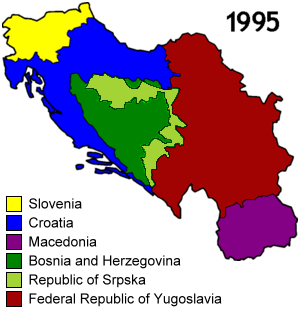AIDS on stamps and the breakup of Yugoslavia
The information in this article was compiled from a series of Wikipedia pages. The entire saga of what happened to Yugoslavia could fill an entire bookshelf so the story has been simplified a great deal. For our purposes, the below history should be sufficient to understand the geopolitics that occurred before, during, and after the release of many AIDS stamps in this region of the world.
This history glosses over the scale of human tragedy that occurred during the breakup of Yugoslavia. I have specifically written it this way not out a lack of compassion for the victims, but because I wanted to focus on geopolitics only as it affects local postal services and our understanding of AIDS stamps.
The maps below are based upon an animated .gif that I found on Wikipedia's Breakup of Yugoslavia page. I have adapted the maps for use on this website as allowed under the terms under the Creative Commons License.
Part one: History
Once upon a time there was a country named Yugoslavia.

For a variety of reasons not relevant to this discussion, the country broke into four parts in 1990 and 1991. In the northwest was Slovenia, in the northwest-central area was Croatia, in the center and south was Yugoslavia, and in the southeast was Macedonia.

At the start of 1992 various groups were in talks about what to do with the large area in western Yugoslavia known as Bosnia and Herzegovina. Generally speaking, the Bosniaks wanted to secede while the Serbs did not. In April, Bosnia and Herzegovina seceded from Yugoslavia. The Serbs immediately seceded from the new country plunging the entire region into a very nasty civil war. Borders for the two new countries would take some time to be established.
In Yugoslavia itself, the majority of the remaining population and government were Serbs with a large contingent of Montenegrans in the southwest. The remaining government claimed to be the "true" nation of Yugoslavia, but the international community did not recognize it as such. As part of this effort, the provinces renamed their country the "Federal Republic of Yugoslavia".

The Serb and Bosniak sections of Bosnia and Herzegovina continued their bloody conflict over their future borders. In the end two nations were formed with a rather unusual border between them. The Bosniak-dominant area became of Bosnia and Herzegovina (officially the "Federation of Bosnia and Herzegovina"). The predominantly Serb area became known as the "Republic of Srpska".
Interestingly, Bosnia and Herzegovina has not one, but two official postal services. The first is the Sarajevo administration (also known as the Muslim administration) in the eastern part of the country. The second is the Mostar administration (also known as the Croat administration) in the south. The Republic of Srpska has one postal service. It is sometimes referred to as the Serb or Banja Luka administration of Bosnia and Herzegovina, particularly during the era of their civil war.

Montenegro is a province in the southwestern corner of what the above map calls Serbia and Montenegro. During the conflicts of the 1990's Montenegro remained allied with the Serbian-led government, but as the years wore on the government of Montenegro became increasingly independent in nature. In 2003, the Federal Republic of Yugoslavia officially renamed the country as Serbia and Montenegro and restructured the government to give Montenegro more freedom.

Alas, this did not stop Montenegro's move toward independence, and Montenegro ultimately seceded in 2006. The territory that did not seceed renamed itself Serbia.

Another province of note is Kosovo. In 1990, Kosovo declared its independence from Yugoslavia. The situation rapidly became violent in spite of only Albania recognizing it as an independent nation. In 1999 the United Nations interceded and occupied the Kosovo on humanitarian grounds. Under United Nations Resolution 1244 Kosovo remained an autonomous part of the Federal Republic of Yugoslavia with UN troops remaining stationed in the province.
In 2008, Kosovo officially declared independence from Serbia. This time numerous western nations (including the USA and most of Kosovo's neighbors) recognized Kosovo as an independent country. Serbia and its allies (including Russia) have not recognized Kosovo and consider it to be a UN-occupied territory of Serbia. The final status of Kosovo remained in dispute for years.

In 2013 following a series of UN-led negotiations between Serbia and Kosovo, Serbia agreed to no longer block Kosovo's intention to someday join the EU. Although Serbia does not officially recognize the Kosovo, the two countries are gradually normalizing relations with each other. In 2014 the International Court of Justice ruled that Kosovo's declaration did not violate international law thereby clearning the way for numerous countries to recognize Kosovo.
Meanwhile in Macedonia, a dispute between Greece and Macedonia over the name Macedonia was resolved in 2019 when the country of Macedonia agreed to rename itself as the Republic of North Macedonia, or just North Macedonia for short.

Part two: Stamps
Last updated: November 30, 2021The countries that once made up Yugoslavia routinely issue semi-postal (ie; postal tax) stamps to fund the Red Cross, health education, health care, etc. These stamps are sometimes on the subject of AIDS and make up an unnusually high number of AIDS stamps.
Here is a list of AIDS stamps known to have been released by these countries. All stamps have been sorted by country as per the categorization system used by the Scott Catalog.
Bosnia and Herzegovina (Croat/Mostar): 2000
Bosnia and Herzegovina (Muslim/Sarajevo): 2002, 2011
Bosnia and Herzegovina (Serb/Banja Luka) / Republic of Srpska: None
Croatia: None
Federal Republic of Yugoslavia: See Yugoslavia
Kosovo: None
Macedonia: 1994, 1995, 1996, 1997, 1998, 1999, 2000, 2001, 2002, 2003, 2004, 2005, 2006, 2007, 2008, 2009, 2010, 2011, 2012, 2016, 2017, 2018
Montenegro: None
North Macedonia: None
Serbia: 2006, 2007, 2011
Serbia and Montenegro: 2004, 2005
Slovenia: None, although they did release a postcard with a pre-printed AIDS stamp on it.
Yugoslavia: 1988, 1999, 2000, 2002